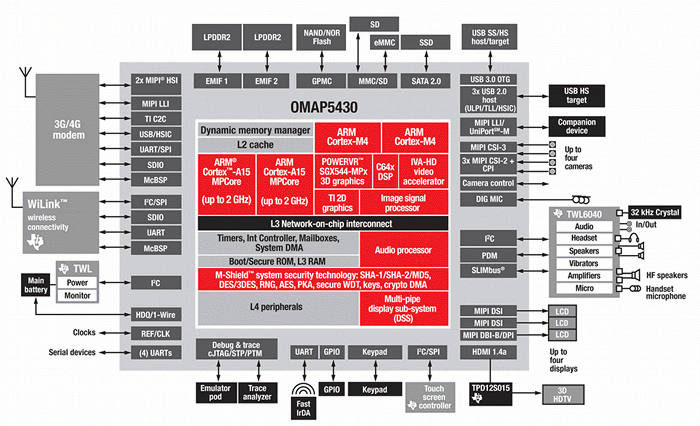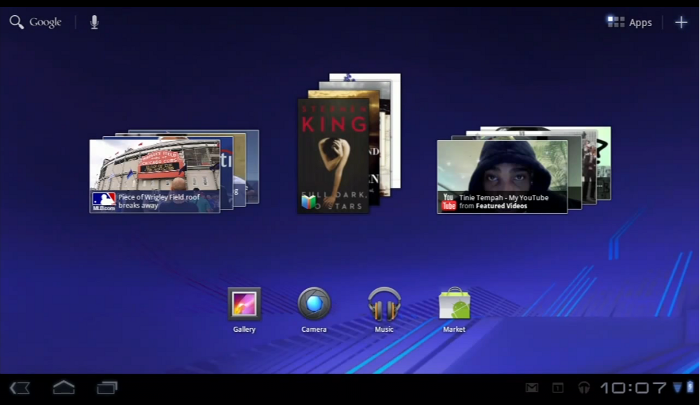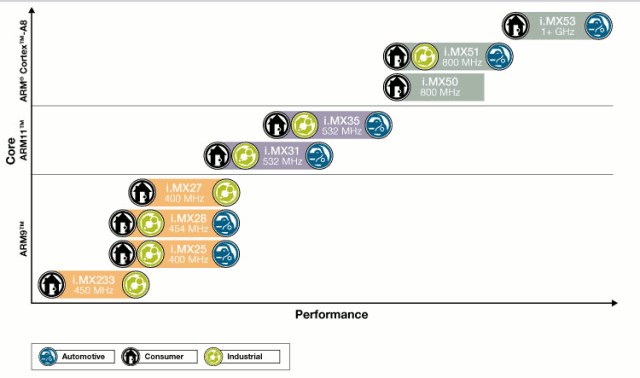Texas Instruments announced its new generation of mobile chips OMAP 5 based on the latest ARM core Cortex A15. Press release excerpt: DALLAS (Feb. 7, 2011) /PRNewswire/ — Texas Instruments Incorporated (TI) (NYSE: TXN) announced today the next generation of its popular OMAP™ family: the OMAP 5 mobile applications platform, which is positioned to transform how mobile devices, such as Smartphones, tablets and other mobile form factors are used, making them even more valuable in our daily lives. … The 28 nanometer OMAP 5 applications processors carry on the OMAP family tradition of delivering significant increases in performance and functionality, while lowering power consumption compared to their predecessors. Specifically, they offer up to 3x processing performance and five-fold 3D graphics improvement, yet provide a nearly 60 percent average power reduction compared to a sample user experience on the OMAP 4 platform. Additionally, the OMAP 5 platform’s software is designed for […]
Android Event: Android 3.0 Presentation and MarketPlace Update
Google Android Event on the 2nd of February 2011 was divided into two part a demo about Android 3.0 (Honeycomb) features on Motorola Xoom (First 30 minutes) and an update on Android market place with the new Android market Webstore. The full event (below) lasts for around 53 minutes. If you are in a hurry, you can check the summary under the video and screenshots. During the Android 3.0 presentation, they showcased some of the platform new features such as the multitask button (e.g. to show recent apps), the grid widget, the stack widget and the new notifications mechanism. They also demo’ed backward compatibility of older apps development for Android 2.x by playing Fruit Ninja game. Then the used Gmail app to show the new features of the application framework suh as fragments, drag and drop and the application bar. They spent a fair amount of time boasting 2D and […]
Ayuda Splash Digital Signage Player Becomes Open Source
Ayuda Media Systems announced OpenSplash – a free, open source digital signage player at ISE 2011. Press Release Excerpt: Ayuda Media Systems (“Ayuda”) announced today at ISE 2011 that it will be open sourcing its Splash Digital Player. Dubbed “OpenSplash”, it is a free, multi-platform open source player that can be driven by any content management and scheduling system. “Offering a free, open source media player will enable a new wave of innovation in the signage industry” said Andreas Soupliotis, President & CEO of Ayuda. “There are a multitude of software vendors in the space that basically all do the same thing – push content from a content management system (CMS) to a network of players. Some do it a little better than others but the differentiation of identity is just not there. If there were a standard open software player that the industry rallied behind then everyone could focus […]
Android 3.0 SDK Preview and Platform Highlights
Google has just released Android 3.0 (Honeycomb) preview SDK and platform highlights. Android 3.0 Highlights Summary New User Features: New UI designed from the ground up for tablets (larger screens) System Bar, for global status and notifications Action Bar, for application control: access to contextual options, navigation, widgets, or other types of content in the Action Bar, displayed at the top of the screen. Five Customizable Home screens with widgets, app shortcuts, and wallpapers using a dedicated visual layout mode. Recent Apps, for easy visual multitasking Redesigned keyboard to improve typing speed/accuracy on tablets. Improved text selection, copy and paste New connectivity options such as Media/Photo Transfer Protocol, USB / Bluetooth keyboards Updated set of standard apps for larger screens. Browser Improvements: Multi-tabs support, “incognito” mode, better browsing experience at non-mobile sites through an improved zoom and viewport model, overflow scrolling, support for fixed positioning, and more. Camera and Gallery: […]
Android Honeycomb Toshiba Tablet based on NVidia Tegra 2
Toshiba setup a website for its upcoming “The Toshiba Tablet,” running Android 3.0 on an Nvidia Tegra 2 processor. It boasts a 10.1″ multi-touch screen with a resolution of 1280×800. It also offers dual cameras (5MP Rear Camera with Auto-focus / 2MP Front Camera), a replaceable battery, a USB, a mini-USB port, Wi-fi, Bluetooth, SD Card, a docking port, HDMI output and a head phone jack. Toshiba Tablet supports up to 720p HD resolution and a 16:10 aspect ratio. The screen also boasts an ambient light sensor in order to provide consistency between indoor and outdoor viewing. The Toshiba tablet won’t be available until Q2 2011 according to Toshiba. While we’re all waiting, here’s “The Toshiba Tablet” teaser video. Jean-Luc Aufranc (CNXSoft)Jean-Luc started CNX Software in 2010 as a part-time endeavor, before quitting his job as a software engineering manager, and starting to write daily news, and reviews full time […]
Freescale i.MX Overview, SDK and Development Boards
Freescale i.MX Processors Overview Freescale i.MX multimedia applications processors are based on ARM9, ARM11 and ARM™ Cortex-A8 and Cortex-A9 core technologies “delivering an optimal balance of performance and long battery life for rich multimedia experiences on the go”. There are quite a few families within the Freescale i.MX Series namely: i.MXS Processors:ARM9 Core @ 100-200Mhz (i.MX1 (not recommended for new designs), i.MXL and i.MXS). i.MX21 Processors: ARM9 Core @ 233-266Mhz (i.MX21 and i.MX21S) i.MX23 Processors: ARM9 Core @ 454 Mhz (i.MX233) i.MX25 Processors: ARM9 Core @ 400MHz for industrial and automotive applications (i.MX251, i.MX253, i.MX255, i.MX257 and i.MX258) i.MX27 Processors: ARM9 Core @ 400Mhz for Video over IP, VoIP, Cordless and Mobile phones… (i.MX27 and i.MX27L) i.MX28 Processors: ARM9 Core @ 454 Mhz for industrial and consumer applications (i.MX281, i.MX283, i.MX285, i.MX286 and i.MX287) i.MX31 Processors: ARM11 Core @ 400-532 Mhz for industrial, consumer and automotive applications (i.MX31 and i.MX31L) […]
Installing Android 2.2 on Sony Ericsson Xperia X10
XDA recently released a ROM with Android 2.2.1 (Froyo) for Sony Ericsson Xperia X10. Bear in mind that this is still a BETA version with the following known bugs and limitations: Closing certain apps will cause the ROM to crash or reboot Youtube / Adobe Flash status uncertain No camcorder recording No native wifi/usb tethering You’ll need to log into the old market at least once before installing the new one Maybe more. All sort of bad things may happen to your phone, but if xRecovery is correctly setup you should be able to recover. If you still want to go forward, following the “simple” steps below. First download the following files: FreeX10-beta2.zip – Xperia X10 Android 2.2 Firmware FreeX10-beta2-hotfix1.zip – flash led brightness and Rockplayer hack gapps_1901_FreeX10.zip– latest Google Apps (Market, Youtube etc.) Here’s what you’ll need before installing Android 2.2: Rooted 2.1 ROM. Instructions for doing so are […]
Android Set-top Box: Bonux HZ20A / HZ20B – ZiiLABS Processors
Bonux, a Taiwan company founded in July 2009, announced two Android 2.2 set-top boxes based on ZiiLABS processors: The Bonux HZ20A and HZ20B. If you can remember Bonux also showcased a 50 USD Android STB earlier on. Here are the specs of the two media players: HZ20A HZ20B OS Android 2.2 CPU Ziilabs ZMS-08 ARM Cortex A8 @ 800 MHz Ziilabs ZMS-05 ARM9 @ 400 MHz RAM 512 MB DDR2 256 MB DDR2 NAND Flash 512MB 256MB Wifi 802.11 b/g/n (Via optional external USB Dongle) Adobe Flash Flash 10.1 FlashLite Video Codecs /Formats MPEG-1/MPEG-2/MPG-4(MP4 & MOV)/DivX(4/5)/Motion JPEG/H.264/WMV9/VC1/Real Video (RMVB – VGA Resolution) Audio Codecs MP3/WAV/WMA/AC3/AAC/OOG Max Resolution/Bitrate 1080p 40 Mbps Subtitles SRT/SMI/SUB/SSA File Systems FAT32 / NTFS(Read-Only) They are not using the default Android user interface, but their own customize UI, which can be a good thing on a TV. Their user interface has the usual Videos, Music, Pictures and […]







